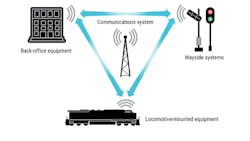NTSB calls on FRA to formulate plan to incorporate new technology that prevents certain train collisions
The National Transportation Safety Board (NTSB) is calling on the Federal Railroad Administration (FRA) to formulate a plan to incorporate promising new technology into the existing system that prevents certain train collisions.
In a report released Nov. 1, the NTSB identified situations where new and emerging technologies can improve the nation’s existing positive train control (PTC) system and benefit rail safety.
PTC is a GPS-based system designed to prevent train-to-train collisions, over-speed derailments, incursions into established work zone limits and the movement of a train through a switch left in the wrong position. PTC is required on tracks with regularly scheduled intercity or commuter passenger rail service and Class 1 railroad main lines carrying poison- or toxic-by-inhalation hazardous materials.
“Implementation of positive train control across our nation’s rail system is undoubtedly a safety win — one the NTSB supported for the [p]ast five decades, and yet, we haven’t achieved zero deaths on our railroads, which means there’s more we can and must do to strengthen safety,” said NTSB Chair Jennifer Homendy.
In the report, NTSB Investigators identified the following safety issues with existing PTC systems:
- Insufficient information about train location during restricted-speed operations
- Obsolete exceptions to PTC use in terminal environments
- Overreliance on administrative controls to prevent unsafe use of switching mode on main tracks
- Unsafe train incursions into established working limits
The NTSB recommended the FRA require railroads to adopt engineering controls that automatically return PTC to the active mode following switching operations and require railroads adopt engineering controls that eliminate the risk of miscommunication between dispatchers and roadway workers in charge regarding established working limits and PTC protection. The report also recommended FRA work with railroads to remove terminal exceptions granted under federal regulations by using new technology.
“This report outlines concrete steps to save lives because part of our mission is to ensure regulators continually raise the bar on safety and that includes evaluating the lifesaving potential of new and emerging technologies,” NTSB said in a statement.
The railroad investigative report which includes the findings and safety recommendations, is available on NTSB’s website.
